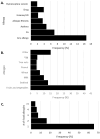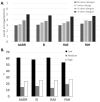Food Allergy Prevalence and Characteristics Among Adults in Cyprus: Effects on Health-Related Quality of Life
- PMID: 40573141
- PMCID: PMC12195849
- DOI: 10.3390/nu17122028
Food Allergy Prevalence and Characteristics Among Adults in Cyprus: Effects on Health-Related Quality of Life
Abstract
Background/Objectives: Food allergy (FA) is an increasing global concern, yet its prevalence, characteristics, and management vary across populations. Country-specific differences have also been observed in the health-related quality of life (HRQL) of patients with FAs. This study aimed to determine the prevalence and characteristics of FAs among Cypriot adults, aged 18-39 years, and explore its effects on HRQL. Methods: A total of 939 randomly selected adults attending universities and colleges across Cyprus completed a questionnaire on demographics and allergy status. Those reporting FA (n = 67, 7.1%) completed the Food Allergy Quality of Life Questionnaire-Adult Form (FAQLQ-AF). The results were analyzed using descriptive and inferential statistics. Results: Fruits/vegetables (40.5%) and seafood (12.6%) were the most common allergens, and 34.3% of participants reported multiple food allergies. Most participants (94%) experienced symptoms within two hours of allergen exposure, yet only 1.5% carried an epinephrine auto-injector, raising concerns regarding access to allergists or the confirmation of IgE-mediated FA. The mean FAQLQ-AF score was 3.32 ± 0.5 (on a scale of 1-7), indicating mild overall impairment. HRQL impairment was greatest in the Food Allergy-Related Health (FAH) domain and lowest in the Avoidance and Dietary Restrictions (AADR) domain, with participants with multiple allergies, concomitant allergic conditions, or severe symptoms reporting the greatest impacts. Conclusions: FA is the most commonly reported allergic disease amongst Cypriot adults and significantly affects their HRQL. The limited confirmation of FA diagnoses through objective methods and the inadequate management of such conditions highlight the need for improved education and access to allergy care for both healthcare providers and patients.
Keywords: Cyprus; adults; food allergy; health-related quality of life (HRQL).
Conflict of interest statement
The authors declare no conflicts of interest.
Figures


Similar articles
-
Skin care interventions in infants for preventing eczema and food allergy.Cochrane Database Syst Rev. 2022 Nov 14;11(11):CD013534. doi: 10.1002/14651858.CD013534.pub3. Cochrane Database Syst Rev. 2022. PMID: 36373988 Free PMC article.
-
Allergen-specific oral immunotherapy for peanut allergy.Cochrane Database Syst Rev. 2012 Sep 12;2012(9):CD009014. doi: 10.1002/14651858.CD009014.pub2. Cochrane Database Syst Rev. 2012. PMID: 22972130 Free PMC article.
-
Individual-level interventions to reduce personal exposure to outdoor air pollution and their effects on people with long-term respiratory conditions.Cochrane Database Syst Rev. 2021 Aug 9;8(8):CD013441. doi: 10.1002/14651858.CD013441.pub2. Cochrane Database Syst Rev. 2021. PMID: 34368949 Free PMC article.
-
Signs and symptoms to determine if a patient presenting in primary care or hospital outpatient settings has COVID-19.Cochrane Database Syst Rev. 2022 May 20;5(5):CD013665. doi: 10.1002/14651858.CD013665.pub3. Cochrane Database Syst Rev. 2022. PMID: 35593186 Free PMC article.
-
A Global Survey of Mental Health Treatment Experiences Among Food Allergy Patients and Caregivers.J Allergy Clin Immunol Pract. 2025 Aug;13(8):2142-2150.e3. doi: 10.1016/j.jaip.2025.05.015. Epub 2025 May 14. J Allergy Clin Immunol Pract. 2025. PMID: 40379241
References
MeSH terms
Substances
LinkOut - more resources
Full Text Sources
Medical
Research Materials
Miscellaneous

